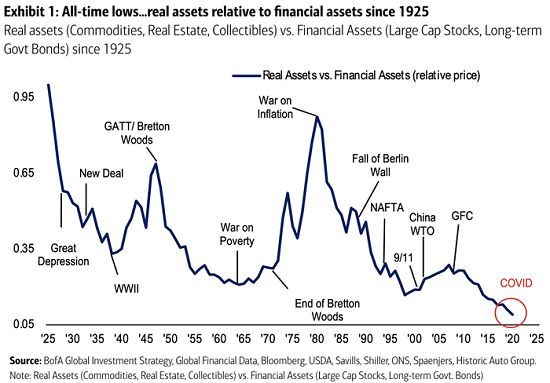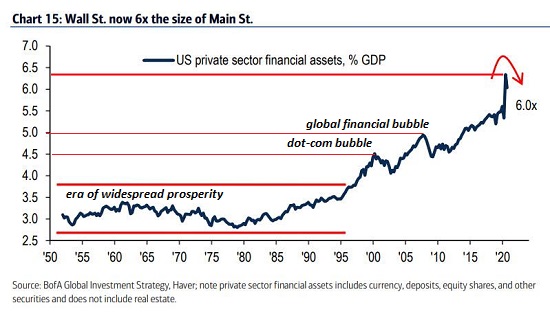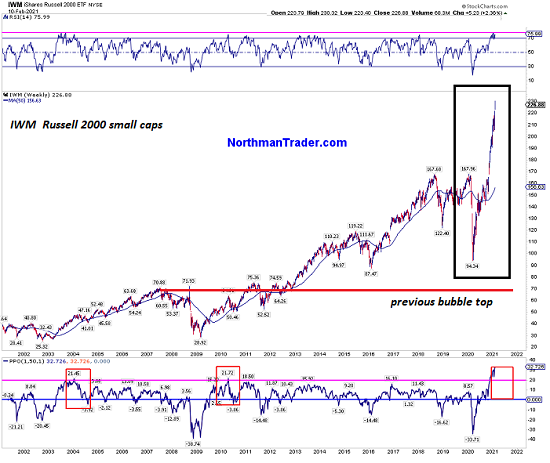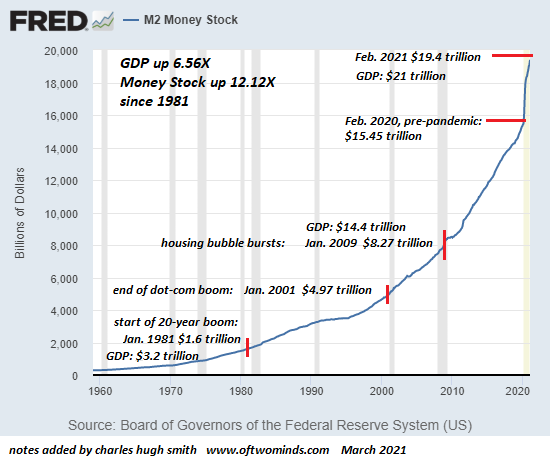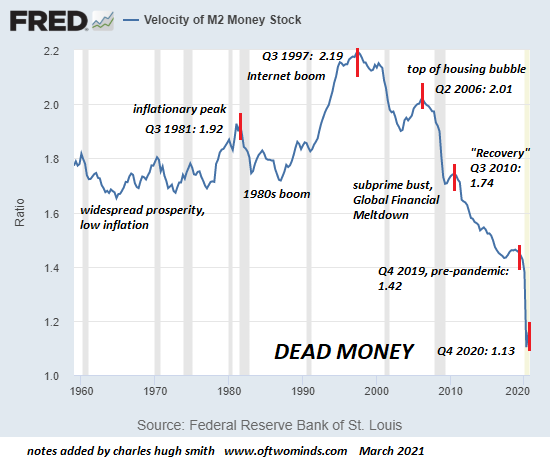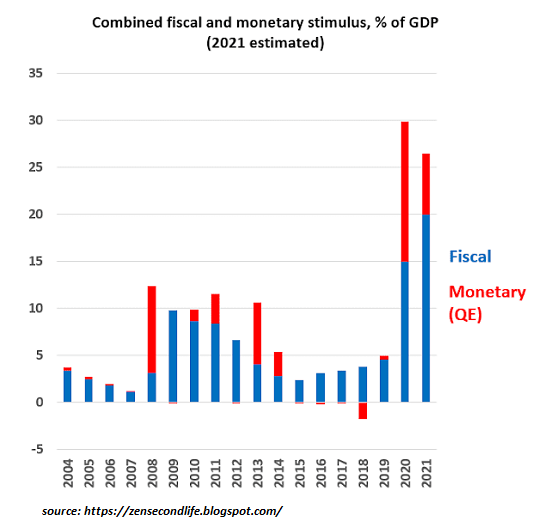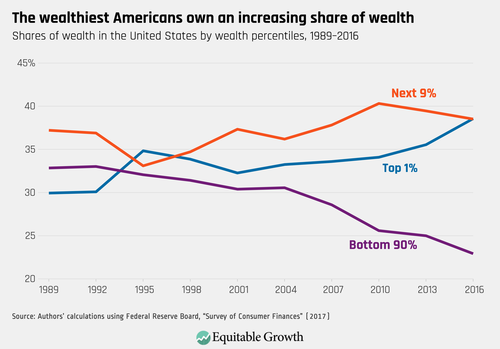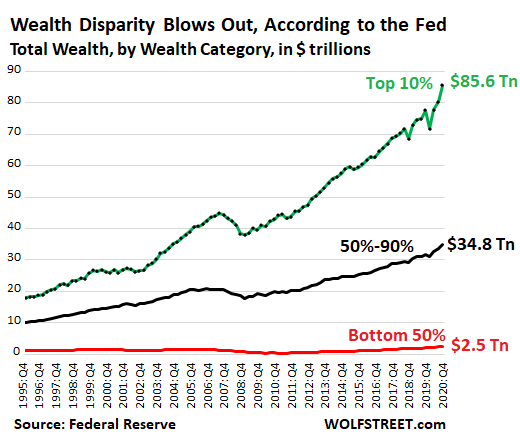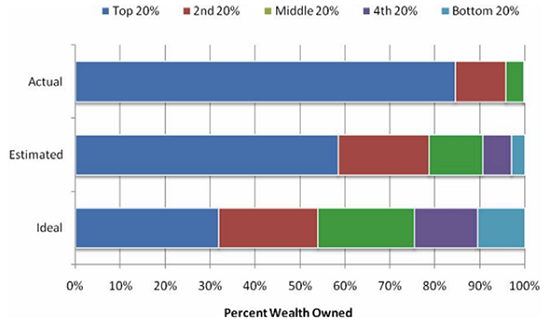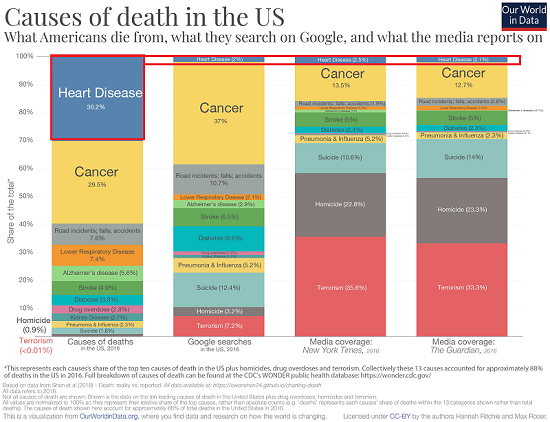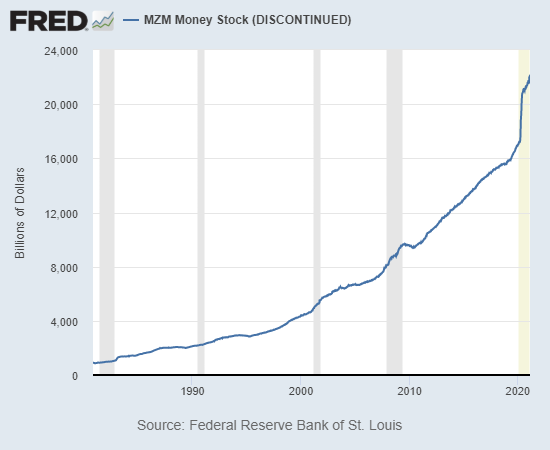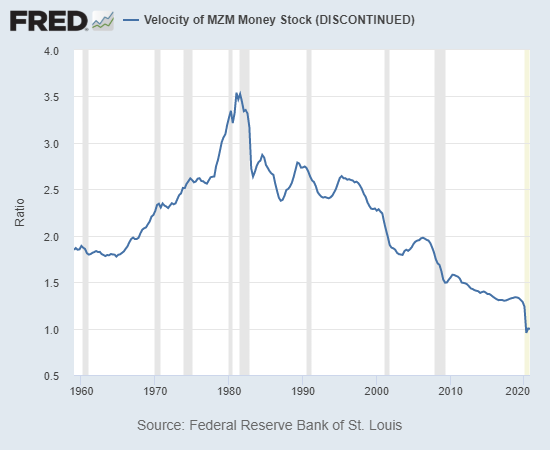Perhaps we have collectively "lost our mind." Perhaps what we need is not a new technology
but a new way of living that uses existing technologies to echo "old ways" that worked rather
well on much lower energy consumption.
The Great Reset is much in the news--the proposed top-down plan for combating climate change
designed by the global elites, who then as now will be jetting around in private aircraft while
dictating exactly how the rest of us will reduce our carbon footprints.
My CLIME proposal takes a much different approach: change the way money is created and people
are paid to create a new incentive structure that lets people and communities decide how best
to reduce energy consumption and waste and address scarcities. (CLIME is described in my
books A Radically Beneficial World: Automation, Technology and Creating Jobs for All
and
A Hacker's Teleology: Sharing the Wealth of Our Shrinking Planet.)
Charlie Munger (head of Berkshire Hathaway) famously said: "Show me the incentive and I will
show you the outcome." That's how humans operate: we respond to the incentives presented, even
if they destroy the planet.
How do we instantiate incentives? With rewards: money, power, status, recognition, praise.
How do we instantiate disincentives? With punishment: imprisonment, fines, closure of businesses,
social shunning.
Being social animals, humans are hard-wired to value status, recognition and praise. But first
we must have a livelihood and some way to feed, clothe and house ourselves. So we must first
have access to the essential resources needed for life, what I call the FEW resources (food,
energy and water).
There are many other resources we need to access, of course--minerals, building materials, and
so on--but the point here is our access to these resources can be direct (you grow your own food)
or indirect (you earn money which you use to buy food).
So money is the key incentive structure, as money is the means to access essential resources.
How you create money determines the outcome: if you create money at the top of the wealth-power
pyramid and distribute it to those at the top, the outcome is a destabilizing asymmetry in the
distribution of money and thus resources. There is no other possible outcome.
Secondly, how you reward people with money determines the outcome: in the present system, we
reward people for creating monopolies and destroying the planet if that maximizes profits, we reward
people for expanding the power of authoritarian states and
we reward people for wasting resources, designing planned obsolescence into everything so the
economy is nothing but a conveyor belt of stuff going through consumers to the landfill: the
Landfill Economy.
With these incentives, rewards and process for creating money, the only possible result is
a doomed, dysfunctional status quo, what we have now. I've laid all this out in greater detail
in my books:
Why Our Status Quo Failed and Is Beyond Reform
Inequality and the Collapse of Privilege
As I always say: If you don't change the way money is created and people are paid, you change
nothing. (I explain the dynamics of money and work in my book
Money and Work Unchained.)
This is why The Great Reset is a fraud: it doesn't change the incentives via how money is created
and people are paid, so it changes nothing. All it does is further consolidate wealth and power
at the top of the wealth-power pyramid.
Relying on The Authoritarian Savior State is also doomed, for reasons I explain in my books
Pathfinding Our Destiny and Resistance, Revolution, Liberation: A Model for Positive Change.)
What we need is The Great Rebalancing, a rebalancing of the planet's resources and human needs.
My proposed CLIME system instantiates the incentives and mechanisms needed to rewire the global
economy.
CLIME is the Community Labor Integrated Money Economy. In CLIME, money is created solely to pay
people for performing useful work in their community. The only way money can be created in CLIME
is to pay people for work the community deems useful and that meets the CLIME standards, which
are simple:
1. The primary goal is not to maximize profit by whatever means are available. (Profit and a
return on capital remain incentives, but they're no longer the only incentives.) The goal is
to use the least amount of energy and resources to perform
the needed work / fill essential scarcities.
2. Every manufactured item must be 95% recyclable or reusable by design, and the cost of this
recycling / reuse is in the initial price.
Consider photovoltaic (solar) panels as an example of what the current system incentivizes.
The current generation of panels is not recyclable at scale--and neither are the lithium-ion
batteries that store the PV electricity. PV panels and lithium-ion batteries are just more
toxic "stuff" going to the landfill in our infinite-growth Landfill Economy.
"The International Renewable Energy Agency (IRENA) estimated that the world had 250,000
metric tons of solar panel waste that year; and by 2050, the amount could reach 78 million
metric tons."
Source
The same is true of thousands of enormous fiberglass wind turbine blades--impossible to recycle
or reuse, they're being buried in giant landfills.
It's difficult for many people to imagine a world in which the incentives are to consume as
little energy and resources as possible and waste as little as possible, but money and the
economy are human constructs: they can be changed at will.
Change the way money is created and people are paid, and you change the incentive structure
and thus the outcome.
We are so accustomed to staggering waste that we cannot imagine how we could manage without
burning 90 million barrels of oil a day (and vast quantities of natural gas and coal).
What never ceases to amaze me is how many people seem to have forgotten that great civilizations
and cities flourished without fossil fuels. The capital of the wondrous Tang Dynasty in China
(near present-day Xian) contained upwards of 1 million people circa 700-900 A.D., and was a
complex entrepot of trade and treasure from distant lands.
The great Thai capital of Ayuttaya also had nearly a million residents in the 1600s and early
1700s before it was sacked and burned by the Burmese army; Westerners had carved out their
own small quarters in the sprawling city.
Neither Imperial Rome nor the Song Dynasty's capital, Hangzhou
(circa 1100-1275 AD) consumed much hydrocarbon energy.
For more on what daily life was like in Hangzhou, find a copy of the marvelous 1964 book
Daily Life in China on the Eve of the Mongol Invasion, 1250-1276.
Paris and the other great cities of Europe thrived in the same timeframe (1600s and 1700s)
with (by today's standards) extremely modest use of fossil fuels.
Those who expect a
decline in energy availability to immediately lead to civilization-ending chaos overlook how similar
life was in 1906 San Francisco, when hydrocarbons generated (by today's standards) modest
amounts of power and biofuel transportation (i.e. horses) were the common form of drayage.
The machinery of that era was terribly inefficient. With current technologies, very modest
amounts of energy could power a very rich lifestyle if we measure lifestyle not by wasteful
consumption but by having enough food to eat, useful work to do, mobility and access to
various entertainments.
Consider this 8-minute film of
Market Street in downtown San Francisco shot a few days before the catastrophic earthquake
and fire of 1906. A trip down Market Street before the fire (Library of Congress)

Yes, there are plenty of jalopies (autos) careening through the traffic, but note the
wealth of transport options. An endless string of cable cars moves up and down Market
Street (that they are cable cars is evidenced by the cable trough running between the rails).
To the right, a procession of horse-drawn carts and wagons head down toward the Bay--the 1906
equivalent of today's diesel trucks.
Toward the end of the film, as the trolley approaches the Ferry Building, you can see a
small horse-drawn trolley entering Market Street (the rear sign identifies it as a "Montgomery
Street" trolley.)
Electric trolleys (note the overhead arm to the conducting wire) crossed the street numerous
times. You will also see many people on foot--still a reliable mode of transport, as well
as bicyclists and an occasional rider on horseback.
On several occasions, people are almost struck by cars; pedestrians, as in Developing World
countries today, had to keep their wits about them. Those unfortunate enough to be struck
very likely did not sue the city or the owner of the vehicle; if you couldn't manage crossing
the street competently, then it was assumed you knew better than to try.
There are no street lights or even police guiding traffic. This is very much like the
semi-chaotic traffic which is commonplace outside the First World.
To the First World resident accustomed to being told what to do and ordered about at all
times, this seems like madness. But notice how it all works quite well without a huge costly
structure to organize and control conformity. Indeed, it is a truism of city-street traffic
control that people drive more cautiously and thus more safely when there are limited or
no traffic controls.
Our present culture cannot grasp the potential of energy devolution. When I heard James
Howard Kunstler speak a few years ago, he observed that many people approached him expecting
a pat on the back for buying a Prius. Jim noted that these souls did not yet "get it"--the
automobile-centric and suburban, auto-dependent economy and culture was the problem, and
the Peak-Lithium auto is no different from the Peak-Oil vehicle. (Manufacturing the Peak-Lithium
auto consumes even more oil than manufacturing the Peak-Oil vehicle.)
From a very basic point of view, the more decentralized options that are available, the better;
just as monoculture crops lead to disease and crop failures, so mono-systems lead to extreme
vulnerabilities.
The "modern" (infinite growth, maximize profits) impulse is to "fix" the vulnerabilities
created by mono-systems with more costly and complex "fixes." Then as these "fixes" trigger
more unforeseen consequences, another round of ever-more complex and costly engineering is
applied to "fix" the "fix."
This is how systems become so high-energy, high cost and complex that the returns of further
investments become ever more marginal, and the system eventually collapses under its own weight.
The idea that a great city could depend largely on human power, animal power, water/wind-based
transport and energy-efficient transport strikes those inculcated with the "infinite growth"
religion/mindset as "primitive."
But if we were able to go back in time and ask the well-fed, well-dressed, well-educated
(and oh-so-busy) passersby on the streets in 1906 if they were living a "primitive," "deprived"
life in a "chaotic" city, they would very likely have reckoned that you had lost your mind.
Perhaps we have collectively "lost our mind." Perhaps what we need is not a new technology
but a new way of living that uses existing technologies to echo "old ways" that worked rather
well on much lower energy densities and much lower energy consumption. (As for relying on A.I.
to save the day and perform miracles, I dismantle this fantasy in my book
Will You Be Richer or Poorer? Profit, Power and A.I.)
The Great Rebalancing need not be painful. We simply need new incentive structures that change
the outcome from waste, fraud, fatal asymmetries and fatal synergies to paying and rewarding
people for doing more with less--much less, and only creating money to pay those doing more with less.
This essay was first published as a weekly Musings Report sent exclusively to subscribers and
patrons at the $5/month ($54/year) and higher level. Thank you, patrons and subscribers, for
supporting my work and this free blog.
If you found value in this content, please join me in seeking solutions by
becoming
a $1/month patron of my work via patreon.com.
My new book is available!
A Hacker's Teleology: Sharing the Wealth of Our Shrinking Planet
20% and 15% discounts (Kindle $7, print $17,
audiobook now available $17.46)
Read excerpts of the book for free (PDF).
The Story Behind the Book and the Introduction.
Recent Podcasts:
AxisOfEasy Salon #40: Subprime Attention NFTs ((1:01 hrs) --NFTs--non-fungible tokens...
The Coming Deflationary Tsunami (53 min)
My COVID-19 Pandemic Posts
My recent books:
A Hacker's Teleology: Sharing the Wealth of Our Shrinking Planet
(Kindle $8.95, print $20,
audiobook $17.46)
Read the first section for free (PDF).
Will You Be Richer or Poorer?: Profit, Power, and AI in a Traumatized World
(Kindle $5, print $10, audiobook)
Read the first section for free (PDF).
Pathfinding our Destiny: Preventing the Final Fall of Our Democratic Republic
($5 (Kindle), $10 (print), (
audiobook):
Read the first section for free (PDF).
The Adventures of the Consulting Philosopher: The Disappearance of Drake
$1.29 (Kindle), $8.95 (print);
read the first chapters
for free (PDF)
Money and Work Unchained $6.95 (Kindle), $15 (print)
Read the first section for free (PDF).
Become
a $1/month patron of my work via patreon.com.
NOTE: Contributions/subscriptions are acknowledged in the order received. Your name and email
remain confidential and will not be given to any other individual, company or agency.
|
Thank you, Valerie M. ($108), for your outrageously generous contribution
to this site -- I am greatly honored by your support and readership.
|
|
Thank you, Richmond A. ($5/month), for your marvelously generous pledge
to this site -- I am greatly honored by your support and readership.
|
Read more...
